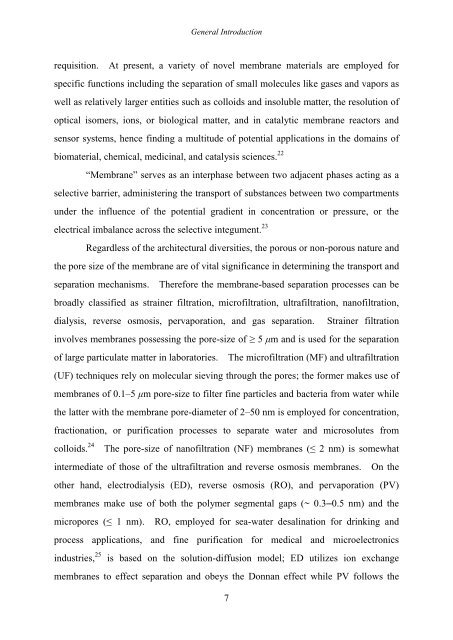Synthesis, Characterization, and Gas Permeation Properties
Synthesis, Characterization, and Gas Permeation Properties
Synthesis, Characterization, and Gas Permeation Properties
You also want an ePaper? Increase the reach of your titles
YUMPU automatically turns print PDFs into web optimized ePapers that Google loves.
General Introduction<br />
requisition. At present, a variety of novel membrane materials are employed for<br />
specific functions including the separation of small molecules like gases <strong>and</strong> vapors as<br />
well as relatively larger entities such as colloids <strong>and</strong> insoluble matter, the resolution of<br />
optical isomers, ions, or biological matter, <strong>and</strong> in catalytic membrane reactors <strong>and</strong><br />
sensor systems, hence finding a multitude of potential applications in the domains of<br />
biomaterial, chemical, medicinal, <strong>and</strong> catalysis sciences. 22<br />
“Membrane” serves as an interphase between two adjacent phases acting as a<br />
selective barrier, administering the transport of substances between two compartments<br />
under the influence of the potential gradient in concentration or pressure, or the<br />
electrical imbalance across the selective integument. 23<br />
Regardless of the architectural diversities, the porous or non-porous nature <strong>and</strong><br />
the pore size of the membrane are of vital significance in determining the transport <strong>and</strong><br />
separation mechanisms. Therefore the membrane-based separation processes can be<br />
broadly classified as strainer filtration, microfiltration, ultrafiltration, nanofiltration,<br />
dialysis, reverse osmosis, pervaporation, <strong>and</strong> gas separation. Strainer filtration<br />
involves membranes possessing the pore-size of ≥ 5 μm <strong>and</strong> is used for the separation<br />
of large particulate matter in laboratories. The microfiltration (MF) <strong>and</strong> ultrafiltration<br />
(UF) techniques rely on molecular sieving through the pores; the former makes use of<br />
membranes of 0.1–5 μm pore-size to filter fine particles <strong>and</strong> bacteria from water while<br />
the latter with the membrane pore-diameter of 2–50 nm is employed for concentration,<br />
fractionation, or purification processes to separate water <strong>and</strong> microsolutes from<br />
colloids. 24 The pore-size of nanofiltration (NF) membranes (≤ 2 nm) is somewhat<br />
intermediate of those of the ultrafiltration <strong>and</strong> reverse osmosis membranes. On the<br />
other h<strong>and</strong>, electrodialysis (ED), reverse osmosis (RO), <strong>and</strong> pervaporation (PV)<br />
membranes make use of both the polymer segmental gaps (~ 0.3–0.5 nm) <strong>and</strong> the<br />
micropores (≤ 1 nm). RO, employed for sea-water desalination for drinking <strong>and</strong><br />
process applications, <strong>and</strong> fine purification for medical <strong>and</strong> microelectronics<br />
industries, 25 is based on the solution-diffusion model; ED utilizes ion exchange<br />
membranes to effect separation <strong>and</strong> obeys the Donnan effect while PV follows the<br />
7

















